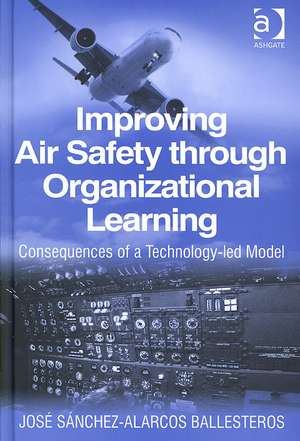Improving Air Safety through Organizational Learning: Consequences of a Technology-led Model
Autor Jose Sanchez-Alarcos Ballesterosen Limba Engleză Hardback – 13 sep 2007
Preț: 890.56 lei
Preț vechi: 1086.05 lei
-18% Nou
Puncte Express: 1336
Preț estimativ în valută:
170.46€ • 185.22$ • 143.28£
170.46€ • 185.22$ • 143.28£
Carte tipărită la comandă
Livrare economică 22 aprilie-06 mai
Preluare comenzi: 021 569.72.76
Specificații
ISBN-13: 9780754649120
ISBN-10: 0754649121
Pagini: 188
Dimensiuni: 156 x 234 x 13 mm
Greutate: 0.45 kg
Ediția:1
Editura: CRC Press
Colecția Routledge
ISBN-10: 0754649121
Pagini: 188
Dimensiuni: 156 x 234 x 13 mm
Greutate: 0.45 kg
Ediția:1
Editura: CRC Press
Colecția Routledge
Public țintă
Academic and Professional Practice & DevelopmentNotă biografică
José Sánchez-Alarcos Ballesteros holds a PhD in Sociology from the Universidad Pontificia de Salamanca in Spain. His thesis, about organizational learning and air safety, was evaluated as summa cum laude. He is currently affiliated as a researcher at COPAC (Commercial Aviation Pilots Association) in Madrid, teaches at the Instituto de Empresa and serves as Managing Partner at Quasar Aviation, providing consultation on quality and safety in commercial aviation.
Recenzii
'Aviation safety has been related to learning for decades. Human and technological considerations in safety must have a more balanced approach. This book explains how to relocate the role of technology in aviation.' Juan Carlos Lozano, IFALPA Accident Analysis Committee 'Timely, necessary, and outspoken - Sanchez-Alarcos Ballesteros’ book explains how our way of learning to be safer may inherently retard our ability to learn more than we already know. He cogently lays out why we need to go beyond even more technology or even more regulations if we want to keep making progress on safety.' Sidney Dekker 'The author presents a sound analysis of how modern aviation systems progressed by relying primarily on complex technology and flawless regulation. While this learning model increases capabilities to manage expected events, it lacks the power to respond adequately to unforeseen ones, because trust in the abilities of the human operator has been relinquished. This is a book that should be read by decision makers in the airframe manufacturing and insurance industries.' Hans-Juergen Hoermann, German Aerospace Center (DLR) 'This book makes for fascinating reading for professionals interested in cognitive and educational psychology; human factors in aviation piloting; aircraft software design, development and usability; transportation safety, policy, economics, and ethics; business management; and organization development. Human factors/ergonomics professionals will be especially interested in this work because of applications to human-computer interaction, human-systems integration, human decision making and individual differences in dynamic environments, modeling/simulation, test/evaluation and training/development.' Ergonomics in Design, Winter 2010
Cuprins
Chapter 1 Commercial Aviation: A High-Risk Activity; Chapter 2 Event Analysis as an Improvement Tool; Chapter 3 Safety in Commercial Aviation: Risk Factors; Chapter 4 Explanation of the Reduction in the Rate of Learning in Complex Environments; Chapter 5 Organizational Learning in Air Safety: Lessons for the Future; Chapter 6 Meaning and Trust as Keys to Organizational Learning; Chapter 7 The Future of Improvements in Air Safety; Chapter 8 Conclusions;
Descriere
The key theme of this book is organizational learning and its consequences for the field of air safety. Air safety rates have been improving for a long time, demonstrating the effects of a good learning model at work. However, the pace of improvement has almost come to a standstill. Improving Air Safety through Organizational Learning explains this situation as being the consequence of a development model supported chiefly by information technology being introduced as an alternative to human operators, and offers a new development model, one that makes strong use of technology but at the same time questions every step and suggests possible ways to recover the lost learning capacity.








